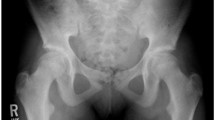Abstract
Whilst delayed treatment of fully dislocated hips diagnosed at birth prejudices final outcome, splinting clinically dislocatable hips is controversial as the majority stabilise spontaneously. Early stabilisation may not ensure normal development but even early splinting carries a small risk of avascular necrosis. We report radiological data from 76 newborns with dislocatable hips that were randomised either to immediate splinting or to sonographic surveillance which examines the influence of early splinting on hip development. Epiphyseal maturation (EM), iliac indentation (II) and acetabular angle (AA) were assessed radiographically at 6 months, blind to the treatment group; hips with normal sonograms at birth had greater EM and II and smaller AA. Whilst clinically unstable Graf type 1 and 2A hips were radiologically similar at 6 months, those splinted showed poorer EM and II compared with non-splinted hips. There were no cases of avascular necrosis. Abduction splinting may displace the femoral capital epiphysis medially resulting in poorer iliac indentation. The smaller epihysis in splinted infants may be secondary to altered blood supply due to increased pressure between the femoral head and acetabulum and increased tension of the adductor muscles in the thigh. These differences were less marked by 1 year. Whether they have any long-term significance requires further study.
Similar content being viewed by others
References
Barlow TG (1962) Early diagnosis and treatment of congential dislocation of the hip. J Bone Joint Surg [Br] 44: 292–301
Dunn PM, Evans RE, Thearle MJ, Griffiths HED, Witherow PJ (1985) Congenital dislocation of the hip: early and late diagnosis and management compared. Arch Dis Child 60: 407–414
McKibbin B, Freedman L, Howard C, Williams LA (1988) The management of congenital dislocation of the hip in the newborn. J Bone Joint Surg [Br] 70: 423–427
Catford JC, Bennet GC, Wilkinson JA (1982) Congenital hip dislocation: an increasing and still uncontrolled disability? Br Med J 285: 1527–1530
Dunn PM (1976) Perinatal observations on the aetiology of congenital dislocation of the hip. Clin Orthop 119: 11–22
Clarke NMP (1986) Sonographic clarification of the problems of neonatal hip instability. J Pediatr Orthop 6: 527–532
Kalamchi A, MacEwen GD (1980) Avascular necrosis following treatment of congenital dislocation of the hip. J Bone Joint Surg [Am] 62: 876–888
Pool RD, Foster BK, Paterson DC (1986) Avascular necrosis in congenital hip dislocation: the significance of splintage. J Bone Joint Surg [Br] 68: 427–430
Fredensborg N (1976) The results of early treatment of typical congenital dislocation of the hip in Malmo. J Bone Joint Surg [Br] 58: 272–278
Gardiner HM, Dunn PM (1990) Controlled trial of immediate splinting versus ultrasonic surveillance in congenitally dislocatable hips. Lancet 336: 1553–1556
Clarke NMP, Harcke HT, McHugh P, Lee MS, Borns P, MacEwen GD (1985) Real-time ultrasound in the diagnosis of congenital dislocation and dysplasia of the hip. J Bone Joint Surg [Br] 67: 406–412
Graf R (1984) Classification of hip joint dysplasias by means of ultrasonography. Arch Orthop Trauma Surg 102: 248–255
Author information
Authors and Affiliations
Rights and permissions
About this article
Cite this article
Gardiner, H.M., Duncan, A.W. Radiological assessment of the effects of splinting on early hip development: Results from a randomised controlled trial of abduction splinting vs sonographic surveillance. Pediatr Radiol 22, 159–162 (1992). https://doi.org/10.1007/BF02012484
Received:
Accepted:
Issue Date:
DOI: https://doi.org/10.1007/BF02012484




